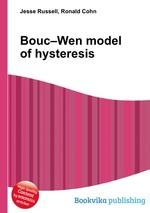Bouc–Wen model of hysteresis
Jesse Russell Ronald Cohn
бумажная книга
High Quality Content by WIKIPEDIA articles! In structural engineering, the Bouc–Wen model of hysteresis is used to describe non-linear hysteretic systems. It was introduced by Bouc and extended by Wen, who demonstrated its versatility by producing a variety of hysteretic patterns. This model is able to capture, in analytical form, a range of hysteretic cycle shapes matching the behaviour of a wide class of hysteretical systems. Due to its versatility and mathematical tractability, the Bouc–Wen model has gained popularity. It has been extended and applied to a wide variety of engineering problems, including multi-degree-of-freedom (MDOF) systems, buildings, frames, bidirectional and torsional response of hysteretic systems, two- and three-dimensional continua, soil liquefaction and base isolation systems. The Bouc–Wen model, its variants and extensions have been used in structural control—in particular, in the modeling of behaviour of magneto-rheological dampers, base-isolation devices for buildings and other kinds of damping devices. It has also been used in the modelling and analysis of structures built of reinforced concrete, steel, masonry, and timber.


